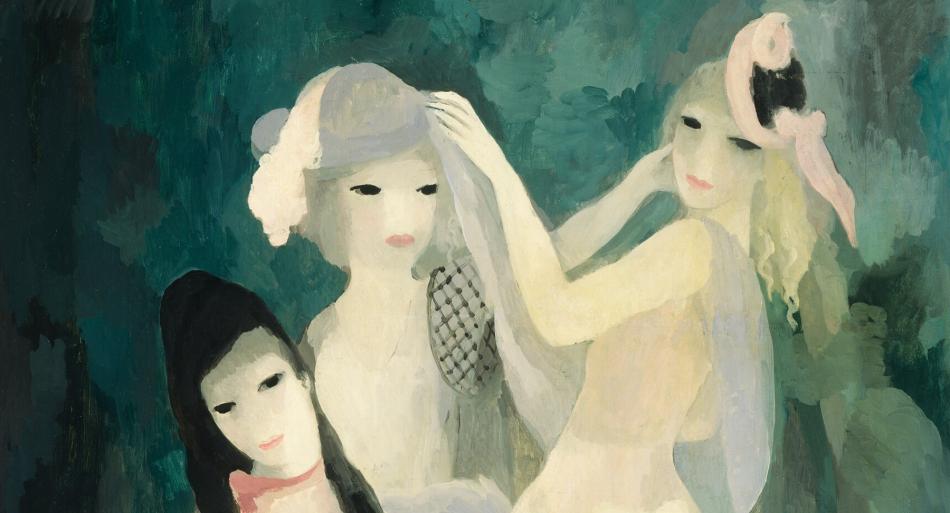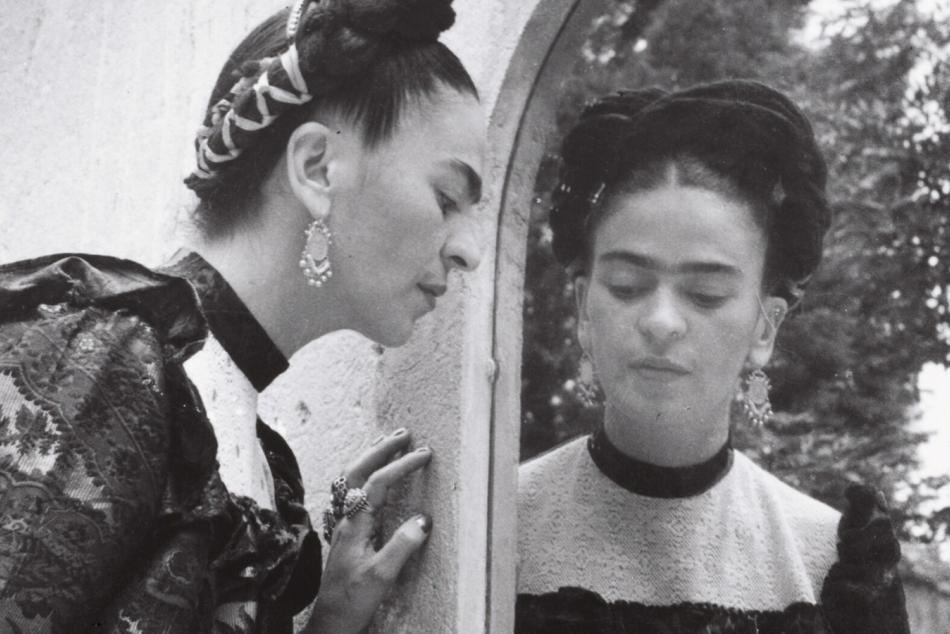Your Tour of LGBTQ+ Artists at the National Gallery

Use our guide to explore 10 works by queer artists on view in our galleries.
Discover the inspiration, communities, and influence of artists from Marie Laurencin to Andy Warhol. Take this guide with you through the galleries. You will need a map. Pick one up at any information desk.
Estimated time for the tour: 45 minutes
East Building
1. Ellsworth Kelly, Color Panels for a Large Wall

“I wanted to give people joy.”
American painter and sculptor Ellsworth Kelly made this spectrum of paintings in 1978—for a bank of all places. He had only recently returned to working in color after a period of using only black and white. The artist attributed his love for color in part to birdwatching. Seeing the creatures fly inspired him to consider the relationship between color and space.
Kelly considered these 18 canvases a single work. He made a new arrangement of the panels for this wall when the work entered our collection in 2005. This tour also includes a work by one of Kelly’s partners, American artist Robert Indiana—see his work below.
Ground Floor, Atrium
2. Gwen John, The Convalescent

“I cannot imagine why my vision will have some value in the world. And yet I know it will.”
Welsh artist Gwen John is known for her paintings and drawings of quiet interiors, often featuring women. Her depictions of friends, fellow artists, and models seated alone in quiet spaces led many to assume she was solitary and introverted. But her striking self-portraits show a self-assured, confident artist.
John worked in London and Paris. She moved in artistic circles with painter James Abbott McNeill Whistler and sculptor Auguste Rodin. (John famously had a 10-year relationship with Rodin. From her letters, we know that she was also involved or infatuated with a number of women.)
During her lifetime, these better-known male artists, as well as her younger brother Augustus, also an artist, overshadowed her. Nevertheless, John was dedicated to her practice and vision.
Ground Floor, Gallery 103
3. Marie Laurencin, In the Park

“Why should I paint dead fish, onions, and beer glasses? Girls are so much prettier.”
French artist Marie Laurencin is known for her ethereal paintings of a world that centered women (and animals). Her pastel-hued odes to feminine beauty established her place in Paris’s avant-garde art scene in the early 20th century. Once famous, Laurencin also made fantastical ballet costumes and sets as well as decorative arts.
Laurencin was part of a circle of creative women in Paris, many of whom were also queer. She regularly attended salons held by American author Natalie Clifford Barney. Author Getrude Stein was one of her first patrons.
Ground Floor, Gallery 103
4. Roni Horn, Opposite of White, v. 2 (Large) (A)

“When I was young, I decided that my sex, my gender, was nobody’s business.”
American conceptual artist Roni Horn plays with the properties of glass. She began her Opposite of White sculptures by gradually pouring liquid glass into a mold. She then allowed them to cool and solidify for months. While the sides remain rough to show the texture of the molds, Horn polishes the top to a smooth, slightly sunken curve, imitating the surface tension of liquid.
Horn’s nonbinary identity informs this work. Standing over the sculpture, you might think you’re looking at a still pool of water—or is it peering deep into a well? You question whether something that appears one way might really be another, or both at once. Just when you think you’ve grasped its nature (solid or liquid), it slips away from you.
Mezzanine, Terrace
5. Marsden Hartley, The Aero

“My work embodies little visions of the great intangible.”
In his early career, artist Marsden Hartley was a groundbreaking American modernist with an innovative painting style. Hartley lived in Berlin, Germany, from 1913 to 1915. There, he befriended painters such as Wassily Kandinsky.
In Germany, Hartley also caught “zeppelin fever,” an international mania for the huge new airships. He wrote to his art dealer Alfred Stieglitz in 1913, “I have one canvas ‘Extase d’Aéroplane’ if it must have a title—it is my notion of the possible ecstasy or soul state of an aéroplane if it could have one.” Hartley may be referring to The Aero, his joyful abstract interpretation of the thrill of going airborne. The layered imagery of the cross and stripes may allude to Karl von Freyburg, his friend and probable lover. A German officer, Von Freyburg was killed early in World War I. Hartley kept one of the shoulder pieces from his military uniform for the rest of his life.
Upper Level, Gallery 415
6. Andy Warhol, Green Marilyn

Beyond his Campbell’s Soup Cans, Green Marilyn may be pop art icon Andy Warhol’s most recognizable work. Warhol first began experimenting with silkscreen printing in August 1962. That same month, Marilyn Monroe died by suicide. Warhol memorialized the movie star using this tightly cropped image of a 1953 publicity still shot during the height of her fame. There are imperfections in the silkscreen technique: the marks on the turquoise background and blotches in her yellow hair. These may refer to Monroe’s fall from greatness.
The artist returned to this image of Monroe over and over again. Some of these works set Monroe’s portrait against a field of gold, like a religious icon. In one of the largest versions, he repeated the identical image 100 times across an enormous, 18-foot-long canvas.
Warhol explored themes such as celebrity, media, and death in many of his silkscreens. But some subjects were more private. For example, Warhol made prints of Archie and Amos, the dachshunds he shared with his then partner, designer Jed Johnson.
Upper Level, Gallery 407
7. Jasper Johns, Perilous Night

“It’s not about what you see, but what you see when you’re looking at it.”
American artist Jasper Johns wanted us to spend time with his works. He hoped viewers would consider the many objects, materials, and textures in his mixed media paintings.
Perilous Night is filled with details. On the right, three casts of arms hang from hooks. A maulstick, a tool painters use to steady their hands, is attached to the right edge. Under it are parts of The Perilous Night, a score by composer John Cage.
Below, a painted handkerchief hanging from a nail. This references Pablo Picasso’s series of paintings of a weeping woman. The wood grain painted behind it depicts Johns’s own front door. The mysterious square of pattern above is not entirely abstract—it is the tracing of a detail of the fallen soldier in Matthias Grünewald’s Isenheim Altarpiece from the 16th century. That same pattern, only enlarged and rotated, takes up the left side of the painting. Together, these elements may refer to the act of artmaking—tracing, copying, and replicating.
Upper Level, Gallery 403-B
Sculpture Garden
1. Robert Indiana, AMOR

“My goal is that LOVE should cover the world.”
American artist Robert Indiana achieved his mission—his image of the stacked four-letter word is now well known. Its success can be credited to Indiana’s skill at mixing advertising graphic design with blocky geometries of abstraction. He began the design as drawings, paintings, and sculptures between 1964 and 1966. Around this time, Indiana’s decade-long relationship with artist Ellsworth Kelly was coming apart. Some versions of LOVE seem to reflect that turmoil. But the design reached a new level of fame when it appeared on an 8-cent stamp in 1973. The image became an emblem for the 1970s.
Since then, the design has been translated into multiple languages, materials, and colors. AMOR, the Spanish or Latin translation, was first made for a plaza in Madrid, Spain, in 2006.
Northeast Quadrant
You may also like

Article: 15 LGBTQ+ Artists to Know
Discover the lives of 15 LGBTQ+ artists and their art, much of which you can see at the National Gallery.

Article: Who Is Ellsworth Kelly? 10 Things to Know
The colorful life of one of the nation’s most important postwar artists.


